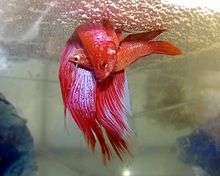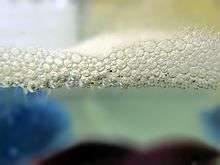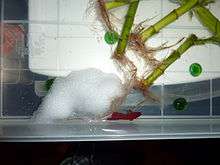Siamese fighting fish
| Siamese fighting fish or betta | |
|---|---|
 | |
| Selectively bred halfmoon male displaying his flared opercula. | |
| Scientific classification | |
| Kingdom: | Animalia |
| Phylum: | Chordata |
| Class: | Osteichthyes |
| Subclass: | Actinopterygii |
| Superorder: | Acanthopterygii |
| Order: | Perciformes |
| Family: | Osphronemidae |
| Subfamily: | Macropodusinae |
| Genus: | Betta |
| Species: | B. splendens |
| Binomial name | |
| Betta splendens Regan, 1910 | |
The Siamese fighting fish (Betta splendens), also sometimes colloquially known as the Betta, is a species in the Gourami family which is popular as an aquarium fish. They are called pla-kad (biting fish) in Thai or trey krem in Khmer. They are a very territorial fish and it is unwise to house two males together. Even the females may become territorial towards each other if not housed in a large enough tank.
These species are native to the Mekong basin of Laos, Cambodia, Vietnam and Thailand. The fish can be found in vast standing waters of canals, rice paddies and floodplains.[1] The species is listed as Vulnerable by the IUCN.
In January 2014 a large population of the fish was discovered in the Adelaide River Floodplain in the Northern Territory, Australia.[2] As an invasive species they pose a threat to native fish, frogs and other wildlife in the wetlands.[2]
Description
B. splendens usually grows to a length of about 6.5 cm (2.6 in).[1] Although aquarium specimens are known for their brilliant colours and large and typically flowing fins, the natural coloration of B. splendens are generally dull green, brown and grey, and the fins of wild specimens are short, about the size of the B. Splendens plakat tail. In captivity, they have been seen with varying fin sizes and varieties and as well as observed coming in colours such as salamander, mustard gas, butterfly, blue, red, white, black and many others.
Diet
Betta splendens in the wild feed on Zooplankton, Crustaceans, and the larvae of mosquitoes and other water-bound insects.[3] However, in captivity they can be fed a steady diet of pellets and frozen foods such as brine shrimp, bloodworms, daphnia and many others.
Despite myths that they will feed on any plant matter in the tank, they are naturally insectivores and would typically never eat vegetation as it is not natural for them to do so.
Reproduction and early development




Male Betta will flare their gills, spread their fins and twist their bodies in a dance if interested in a female. If the female is also interested she will darken in colour and develop vertical lines known as breeding bars as a response. Males build bubble nests of various sizes and thicknesses at the surface of the water. Most tend to do this regularly even if there is no female present.
Plants or rocks that break the surface often form a base for bubble nests. The act of spawning itself is called a "nuptial embrace", for the male wraps his body around the female; around 10–40 eggs are released during each embrace, until the female is exhausted of eggs. The male, in his turn, releases milt into the water, and fertilization takes place externally. During and after spawning, the male uses his mouth to retrieve sinking eggs and deposit them in the bubble nest (during mating the female sometimes assists her partner, but more often she simply devours all the eggs she manages to catch). Once the female has released all of her eggs, she is chased away from the male's territory, as she will likely eat the eggs.[4] If she is not removed from the tank then she will most likely be killed by the male.
The eggs will remain in the male's care. He carefully keeps them in his bubble nest, making sure none fall to the bottom, repairing the bubble nest as needed. Incubation lasts for 24–36 hours; newly hatched larvae remain in the nest for the next two to three days until their yolk sacs are fully absorbed. Afterwards, the fry leave the nest and the free-swimming stage begins. In this first period of their lives, B. splendens fry are totally dependent on their gills; the labyrinth organ which allows the species to breathe atmospheric oxygen typically develops at three to six weeks of age, depending on the general growth rate, which can be highly variable. B. splendens can reach sexual maturity at an age as early as 4–5 months.
History
Some people of Thailand and Malaysia are known to have collected these fish prior to the 19th century from the wild.
In the wild, betta spar for only a few minutes before one fish backs off. Bred specifically for heightened aggression for fighting, domesticated betta matches can go on for much longer, with winners determined by a willingness to continue fighting. Once a fish retreats, the match is over.
Seeing the popularity of these fights, the king of Thailand started licensing and collecting these fighting fish. In 1840, he gave some of his prized fish to a man who, in turn, gave them to Theodor Cantor, a medical scientist. Nine years later, Cantor wrote an article describing them under the name Macropodus pugnax. In 1909, the ichthyologist Charles Tate Regan, realizing a species was already named Macropodus pugnax, renamed the domesticated Siamese fighting fish Betta splendens.[5]
In 1892, this species was imported to France by the French aquarium fish importer Pierre Carbonnier in Paris, and in 1896, the German aquarium fish importer Paul Matte in Berlin imported the first specimens to Germany from Moscow.[6]
In the aquarium
Water
Betta species prefer a water temperature of around 23–27 °C (73.4-80.6 °F) but have been seen to survive at the extremes of 20 and 30 °C (68 and 86 °F) though their life quality may be diminished at these extremes of the betta's tolerance. Bettas are also affected by the pH levels of the water. Most ideal levels for Bettas would be at a neutral pH (7.0) However, Bettas are slightly tolerant towards the pH levels.[7] They have an organ known as the labyrinth organ which allows them to breathe air at the water's surface. This organ was thought to allow the fish to be kept in unmaintained aquaria,[8] but this is a misconception, as poor water quality makes all tropical fish, including Betta splendens, more susceptible to diseases such as fin rot.
Properly kept and fed a correct diet, Siamese fighting fish generally live between 3–5 years in captivity, but may live between 7–10 years in rare cases.
Aquarium size
It is popular to keep betta fish in very small containers for display around the home. Contrary to popular belief this can stress the fish causing health issues. Bettas prefer to be kept in larger tanks or community tanks. The smallest tank recommended is 20 litres, or 5 gallons, and bigger is advisable.[9]
Varieties
B. splendens can be hybridized with B. imbellis, B. mahachaiensis, and B. smaragdina, though with the latter, the fry tend to have low survival rates. In addition to these hybrids within the Betta genus, intergeneric hybridizing of Betta splendens and Macropodus opercularis, the paradise fish, has been reported. A fairly recent variety to hit the markets is the king betta, a variety of largely unknown provenance which may or may not be derived from crossing B. splendens with B. raja.[10]
Breeders around the world continue to develop new varieties. Often, the males of the species are sold preferentially in stores because of their beauty, compared to the females. Recently, breeders have developed in females the same range of colours previously only bred in males. Females almost never develop fins as showy as males of the same type and are often more subdued in coloration, though some breeders manage to get females with fairly long fins and bright colours.
Colors

Wild fish exhibit strong colours only when agitated. Breeders have been able to make this coloration permanent, and a wide variety of hues breed true. Colours available to the aquarist include red, orange, yellow, blue, steel blue, turquoise/green, black, pastel, white ("opaque" white, not to be confused with albino) and multi-coloured fish.
Bettas are found in many different colours due to different layers of pigmentation in their skin. The layers (from furthest within to the outer layer) consists of red, yellow, black, iridescent (blue and green), and metallic (not a colour of its own, but reacts with the other colours to change how they are perceived). Any combination of these layers can be present, leading to a wide variety of colours.[11]
The shades of blue, turquoise, and green are slightly iridescent, and can appear to change colour with different lighting conditions or viewing angles; this is because these colours (unlike black or red) are not due to pigments, but created through refraction within a layer of translucent guanine crystals. Breeders have also developed different colour patterns such as marble and butterfly, as well as metallic shades through hybridization[12] like copper, gold, or platinum (these were obtained by crossing B. splendens to other Betta species).

A true albino betta has been feverishly sought since one recorded appearance in 1927, and another in 1953 . Neither of these was able to establish a line of true albinos. In 1994, a hobbyist named Kenjiro Tanaka claimed to have successfully bred albino bettas.[13]
Some bettas will change colours throughout their lifetime (known as marbling), attributed to a transposon.[14]
Common Colours[15]
- Red
- Blue
- Green
- Yellow
- Opaque
- Black
- White
- Orange
Interesting Colours[15]
- Metallic
- Turquoise
- Copper
- Lavender
- Mustard Gas
- Grizzle
- Kois
- Marble
Colour patterns[15]
- Solid - The entire fish is one colour with no variations
- Bi-colour - The fins must be a different colour to the body to be a Bi-colour.
- Cambodian - The body is pale, almost colourless, and the fins are a solid colour
- Butterfly - The fins have distinct bands of colours
- Marble - Irregular patterns throughout the body and fin
- Piebald - pale flesh-coloured face irrespective of the body colour.
- Full Mask - the face being the same colour as the body rather than what it would naturally be which would be darker than the body
- Dragon - rich strong base colour with the scales on the main part of the body a pale iridescent
- Multicolour - 3 or more colours on the body that does not fit into any other pattern category
- Pastel - A light shade of colour seen only on the fins, body remains a flesh hue.
Finnage variations[15]


Breeders have developed several different finnage and scale variations:
- Veil tail (extended finnage length and non-symmetrical tail; caudal fin rays usually only split once) the most common tail type seen in pet stores.
- Crown tail (fin rays are extended well beyond the membrane and consequently the tail can take on the appearance of a crown; also called fringetail)
- Comb tail (less extended version of the crown tail, derived from breeding crown and another finnage type)
- Half-moon ("D" shaped caudal fin that forms a 180° angle, the edges of the tail are crisp and straight)
- Over-half-moon or Super Delta tail (caudal fin is in excess of the 180° angle, byproduct of trying to breed half-moons, can sometimes cause problems because the fins are too big for the fish to swim properly)
- Rose tail (halfmoon variation with so much finnage that it overlaps and looks like a rose)
- Feather tail (similar to the rose tail, with a rougher appearance)
- Short-finned fighting style (sometimes called "plakat")
- Half-moon plakat (short-finned half-moon, plakat and half-moon cross)
- Double tail or Full-moon (the tail fin is duplicated into two lobes and the dorsal fin is significantly elongated, the two tails can show different levels of bifurcation depending on the individual)
- Delta tail (tail spread less than that of a half-moon [<180])
- Half-sun (combtail with caudal fin going 180°, like a half-moon)
- Elephant ear (pectoral fins are coloured, and much larger than normal, resembling the ears of an elephant)
- Spade tail (caudal fin has a wide base that narrows to a small point)
Behaviour
Males and females flare or puff out their gill covers (opercula) to appear more impressive, either to intimidate other rivals or as an act of courtship. Other reasons for flaring can include when they are intimidated by movement or change of scene in their environments. Both sexes display horizontal bars if stressed or frightened. However, such colour changes, common in females of any age, are rare in mature males due to their intensity of colour. Females often flare at other females, especially when setting up a pecking order. Flirting fish behave similarly, with vertical instead of horizontal stripes indicating a willingness and readiness to breed (females only). Betta splendens enjoy a decorated tank, being a territorial fish it is necessary to establish territory even when housed alone. They may set up a territory centered on a plant or rocky alcove, sometimes becoming highly possessive of it and aggressive toward trespassing rivals. This is the reason why when kept with other fish the minimum tank size should be 45 litres(about 10 gallons). Contrary to popular belief, Bettas are compatible with many other species of aquarium fish.[16] Given the proper parameters bettas will be known to only be aggressive towards smaller and slower fish than themselves such as guppies.[17]
The aggression of this fish has been studied by ethologists and comparative psychologists.[18] These fish have historically been the objects of gambling; two male fish are pitted against each other to fight and bets are placed on which one will win. One fish will arise the victor, the fight continuing until one participant is submissive. These competitions can result in the death of either one or both fish depending on the seriousness of their injuries. To avoid fights over territory, male Siamese fighting fish are best isolated from one another. Males will occasionally even respond aggressively to their own reflections in a mirror. Though this is obviously safer than exposing the fish to another male, prolonged sight of their reflection may lead to stress in some individuals. Not all Siamese fighting fish respond negatively to other males, especially when the tank is large enough for each fish to create their own designated territory.[19]

Name
Although commonly called a betta in the aquarium trade, especially in North America, that is the name of a genus not only containing this fish, but also other species. B. splendens is more accurately called by its scientific name or "Siamese fighting fish", to avoid confusion with the other species in the genus.
References
- 1 2 Froese, Rainer and Pauly, Daniel, eds. (2014). "Betta splendens" in FishBase. February 2014 version.
- 1 2 Bray, Dianne. "Siamese Fighting Fish, Betta splendens". Fishes of Australia. Retrieved 29 September 2014.
- ↑ "betta food". Bettatalk.com. Retrieved 2012-08-01.
- ↑ Leong, Paul (2004). Tips on Spawning Bubblenesting Bettas. Retrieved on March 13, 2009.
- ↑ "Betta Origins". Betta Fish Center. Retrieved 11 June 2011.
- ↑ "Betta splendens -article-". kcff.net.
- ↑ "betta water". www.bettatalk.com. Retrieved 2015-10-05.
- ↑ Caller, Steven. "Betta Fish Introduction". My Betta Fish. Retrieved 2012-08-01.
- ↑ http://japanesefightingfish.org/betta-fish-care/
- ↑ Juniper Russo (2009): "King Betta" Variety Sold at Petco
- ↑ Griffin, Gerald (January 2016). "Betta Primer". Amazonas. Shelburne, VT: Reef to Rainforest Media.
- ↑ "Metallics and Masked". Betty
Splendens.
com. - ↑ "Albino image". Retrieved 2012-08-01.
- ↑ http://www.ibcbettas.org/2012/wp-content/uploads/2012/11/IBC%20TA%20Articles/CS-02.pdf
- 1 2 3 4 "Colors & Patterns". Retrieved 2015-10-04.
- ↑ "7 Excellent Betta Tank Mates for Your Siamese Fighting Fish". Retrieved 2015-08-20.
- ↑ "Betta Fish Facts". Retrieved 2015-08-20.
- ↑ Bronstein, Paul M. (1998). "Agonistic Sequences and the Assessment of Opponents in Male Betta splendens". American Journal of Psychology. 265 (2): 163–177. JSTOR 1422809.
- ↑ "Complete Betta Fish Care Guide (Tank, Diet & Aggression)". Retrieved 2016-03-03.
Further reading
- Simpson, M. J. A. (1968). "The display of the Siamese fighting fish Betta splendens". Animal Behaviour Monographs. 1: 1–73.
- Thompson, T (1966). "Operant and Classically-Conditioned Aggressive Behavior in Siamese Fighting Fish". American Zoologist. 6: 629–741. doi:10.1093/icb/6.4.629.
External links
| Wikimedia Commons has media related to Betta splendens. |
| The Wikibook Do-It-Yourself has a page on the topic of: Breed siamese fighting fish |
- International Betta Congress
- BETTAFISH subreddit
- Aquarium Network
- Betta Fish Care: How to care for Bettas
- How To Breed Bettas
- Bettas at DMOZ
